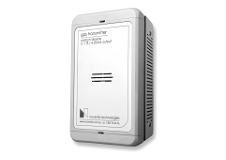Carbon dioxide Detection
Carbon dioxide (CO2) is a chemical compound composed of one carbon and two oxygen atoms. At room temperature carbon dioxide is a colourless and odourless gas and non-flammable. It is present in the Earth's atmosphere at a low concentration and acts as a greenhouse gas. In solid state, it is called dry ice. It is a major component of the carbon cycle.
Atmospheric Carbon dioxide is an important greenhouse gas that helps to trap heat in our atmosphere. Without it, our planet would be inhospitably cold. Carbon dioxide is released through human activities such as deforestation and burning fossil fuels, as well as natural processes such as respiration and volcanic eruptions. It is also produced by various microorganisms from fermentation and cellular respiration. Plants convert carbon dioxide to oxygen during a process called photosynthesis, using both the carbon and the oxygen to construct carbohydrates. In addition, plants also release oxygen to the atmosphere, which is subsequently used for respiration by heterotrophic organisms, forming a cycle. Carbon dioxide can also dissolve in sea water.
Carbon dioxide makes up less than 1% of the atmosphere. For the past 100 years, carbon dioxide has been added to the atmosphere more quickly than it is removed. Scientists estimate that before human industrial activity, CO2 concentration was around 270 ppm. Carbon dioxide levels in our atmosphere have thus risen about 40% since the onset of human industrialization, and are expected to play a troubling role in the raising global temperature. Earth's early atmosphere had much higher CO2 levels and almost no oxygen; the rise of photosynthetic organisms led to an increase in oxygen which enabled the development of life on planet earth.
Applications
Carbon dioxide in solid and in liquid form is used for refrigeration and cooling applications. It is used as an inert gas in chemical processes, such as MIG/MAG welding , in the storage of carbon powder and in fire extinguishers. In the Food and Beverages industry, Carbon dioxide gas is used to carbonate soft drinks, beers and wine and to prevent fungal and bacterial growth. Liquid carbon dioxide is a good solvent for many organic compounds. It is used to de-caffeinate coffee.
Carbon dioxide is also used to inflate bicycle tires and life jackets and to power paintball guns. Foam in soda pop is supplied by carbon dioxide. Carbon dioxide is also released by yeast during fermentation, giving beer its head and making champagne bubbly. Because it is not flammable, CO2 is used in some fire extinguishers. Carbon dioxide forms a weak acid, called carbonic acid (H2CO3), when dissolved in water.
Gas Specifications
- Gas Name: Carbon Dioxide
- Formula: CO2
- CAS No.: 124-38-9
- TWA: 5000 ppm
- LEL: Not explosive
- Density relative to air: 1.52
Selecting a Carbon Dioxide detector
Carbon dioxide has been recognised as a workplace hazard at high concentrations. Generally stored in confined spaces such as cellars or cool rooms, a leaking cylinder can result in a build-up of gases. These gases, if inhaled by humans, can result in asphyxiation and possible death. Whilst leaks causing dangerous levels of CO2 can often not be prevented, human exposure can be. Testing and monitoring of these spaces are crucial to providing a safe working environment and ensuring oxygen remains at safe levels.
A common misunderstanding is using an Oxygen detector to detect leaks of Carbon Dioxide. To illustrate the risk doing so, please refer to the table below.
| CO2 | Oxygen | Nitrogen | Other Gases |
|---|---|---|---|
| 0% | 21.00% | 78.00% | 1% |
| 1% | 20.80% | 77.20% | 1% |
| 2% | 20.60% | 76.40% | 1% |
| 3% | 20.40% | 75.70% | 1% |
| 4% | 20.20% | 74.90% | 1% |
| 5% | 20.00% | 74.10% | 1% |
| 6% | 19.70% | 73.30% | 0.90% |
| 7% | 19.50% | 72.50% | 0.90% |
| 8% | 19.30% | 71.80% | 0.90% |
| 9% | 19.10% | 71.00% | 0.90% |
| 10% | 18.90% | 70.20% | 0.90% |
In view of above, we recommend using an infrared carbon dioxide detector for detection of CO2. The initial purchase price may be higher; however they last for many years, often with minimal to no maintenance and the need for sensor replacements. The total cost of ownership is much lower compared to a standard oxygen detector.
We offer a range of infrared carbon dioxide detectors, all for specific applications. A part of the evaluation process is a risk assessment to ensure the detection system is tailored to your needs. Our engineers can assist and select the correct sensor for your application. Contact us for more information.



